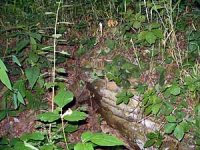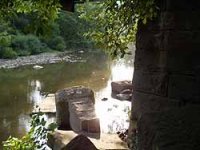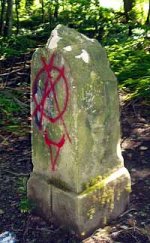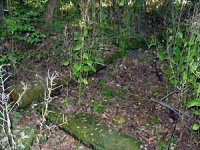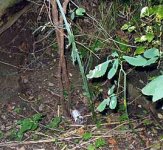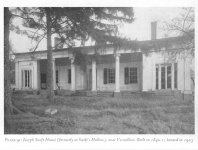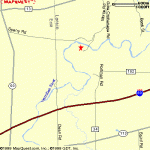Gypsy Heart
Gold Member
In the late 1800's, there once stood a place in Vermilion called Light and Hope Orphanage. Today, all that remains of the orphanage is the foundation, as well as some sandstone pillars. The ruins can be found along a trail off Gore Orphanage Road.
Do the ruins still exist? Yes. Did children die here? Yes, at least six. Are there supernatural and/or strange elements involved that would justify the widespread notoriety of this place? Absolutely.
First, to get the story straight.
Prior to the 1960's this area was more commonly known as Swift's Hollow. It is named after Joseph Swift, who moved here with his wife Eliza in the late 1820's and built an estate along the Vermilion River, including a house known as "Swift's Mansion." According to Penn State Professor William Ellis, the mansion was the most elaborate of its kind at this time. Because Swift's estate was so ostentatious, it drew much attention by others, who soon referred to his estate as Swift's Hollow. This place continued to be known as Swift's Hollow for almost 100 years.
Bad luck hit the Swift family, starting soon after they arrived. Research revealed that in 1831, Swift's 5 year-old daughter Tryphenia died. In 1841, Swift's 24 year-old son, Heman, also died. (What interesting names these children had). According to Professor Ellis, in the 1860's, Joseph Swift sustained a devastating financial loss over some bad railroad investments and in 1865 was forced to sell the Swift Mansion.
Nicholas Wilber purchased the property from Swift. Soon thereafter, Swift's Hollow developed an even eerier reputation. According to Professor Ellis, Nicholas Wilber was a spiritualist who was known to hold séances within the Swift Mansion. Of course, this fact is hardly surprising since the spiritualist movement was quite popular at this time. However, there is little doubt that the local folk in this relatively rural area found Mr. Wilber's practices to be more sinister. Professor Ellis notes that "many wild and weird stories were told about the place during and after [the Wilbers'] occupancy."
Like the Swifts, the Wilber family suffered great tragedy while living in the Swift Mansion. The Wilbers lost four of their grandchildren to diphtheria--Jesse, age 11; May, age 9; and twins Roy and Ruby, age 2. These poor children all died within 6 days of each other, from January 13th to January 19, 1893. They died in the Swift Mansion.
Eliza Wilber died in 1899. Nicholas Wilber died in February 26, 1901.
After the death of Nicholas, the Swift Mansion was abandoned and fell into ruin. Even during the early 1900's, the mere existence of an abandoned house with a history of death was sufficient to spark the imagination of others. Professor Ellis notes that it was at this time that rumors started to circulate that Swift Mansion was haunted and that "neglected children's graves" were found on the estate.
In 1903, most of Swift's Hollow was purchased by Reverend Sprunger, who built the "Light and Hope Orphanage" for the purpose of caring for and giving farming vocational training to neglected children.
For reasons unknown, the Swift Mansion was never occupied by the children. Rather than house the children in the mansion, Rev. Sprunger instead built dorms around Swift's Hollow, or housed the children in existing farmhouses that he bought from others.
According to Prof. Ellis, the "Light and Hope Orphanage" did not last long. Rev. Sprunger died in 1912. In 1916 the orphanage was closed for good. A dorm and workhouse burned down soon thereafter. However, no children were killed in the fires. In 1926, the abandoned Swift Mansion burned down.
So how come there's a "Gore Orphanage Road?" According to Prof. Ellis, as well as others, this road was originally named "Gore Road." It was named after the "gore" or skirt-hem shape of the road leading to Swift Hollow. "Orphanage" was added to the name much later, after years of associating the road with Rev. Sprunger's orphanage.
All that remains of Swift Mansion is the foundation and columns, which are mistaken as the "Gore Orphanage." The Swift Mansion can be found by accessing a trail off Gore Orphanage Road, on the other side of the bridge.
Earlier versions of this legend confirm that Swift Mansion and the orphanage are separate and distinct sites, located on opposite sides of the bridge.
For over a century visitors to Gore Orphanage Road have reported strange experiences of glowing lights, apparitions and chilling cries of unseen children. The area is said to be one of the most haunted locations in Ohio.
Despite the inaccuracies of the Gore Orphanage legend, the true tale of the institution and the Swift's Hollow mansion are more haunting than fiction. Light of Hope, the actual name of the orphanage, was established in 1902 by a religious zealot
named Reverend Johann Sprunger. The orphanage was located on Gore Road. The road was originally laid out along the boundary line dividing Lorain County from its western neighbor, Huron County. When a surveying error was discovered, a thin strip of land resembling the gore of a dre had to be annexed to Lorain. Due to the popular association of the institution with the road, the name of the street came to be known as Gore Orphanage Road - a fitting name for the location of a now infamous orphanage with a hellish history.
Johann Sprunger and his wife Katharina moved to the Vermilion area after their former orphanage in Berne, Indiana was destroyed by fire. Katharina was the daughter of Christian P. Sprunger. Though no explanation has ever been given regarding Katharina's surname being the same as her husband, a diary of a worker at the former Light of Hope Orphanage in Berne states that the orphanage was run by "Brother and Sister Sprunger." Three orphan girls were reported to have perished in the original Light of Hope fire. Two of Sprunger's former Indiana businesses had also ended by fire. Prior to moving to Ohio the couple also lost their seven year old daughter, Hillegonda, and a son, Edmund, died at birth. The deaths appeared to spark a passionate obsession for religious pursuits in the couple.
The new orphanage site, just outside of Vermilion, consisted of four sets of farm buildings and covered 543 acres. An abandoned mansion was also located on the property. The once magnificent Greek revival house was built in the mid-nineteenth century by Joseph Swift, a successful farmer. Its many rooms were appointed with elaborate furnishings, ornate woodwork, marble columns, and other lavish decorations. But to the Swift mansion soon came bad luck. In 1831, Swift's 5 year-old daughter Tryphenia died. In 1841, Swift's 24 year-old son, Heman, also died. Soon after Swift's fortunes dried up due to poor investments in the railroad business. He sold the home to Nicholas Wilber, a renowned Spiritualist. Mysterious rituals and seances were said to be held regularly in the secluded mansion home conjuring up the spirits of deceased children. The ghosts of children were said to appear frequently at the seances held in a special room of the home. Wilber's children were rumored to be psychic and could communicate with the ghosts of dead children. While records and gravestones claim that four Wilber grandchildren died from a diphtheria epidemic after the Wilbers moved from the home, residents insisted that they died at the Swift mansion and were buried there. The home was abandoned in 1901, and teenagers almost immediately began taking trips to the site, daring each other to enter the infamous haunted home.
Rev. Sprunger did not utilize the abandoned home for the new orphanage. Instead, he attempted to build a new, self-sustaining religious community on the property. He and his co-workers were devout Bible-believing Christian people. A chapel room was located in the boy’s schoolhouse for frequent religious ceremonies. Up to one hundred and twenty children were inmates of the orphanage at one time. Boys lived at a farm called the Hughes farm and girls at the Howard farm. The orphanage also housed a small printing press used to print their own school books, as well as a paper entitled "Light of Hope."
But rumors of darkness and despair soon plagued the Light of Hope orphanage. Orphan children ran away from the home, often wading through the Vermilion River to escape to Vermilion. The children told horrific stories of abuse, neglect and slave labor. The children were said to eat a diet of calves lungs, hog heads and sick cattle - if they were fed at all. Corn
was boiled in the same pot used to boil soiled underwear. Although there were cows on the farm, children were said to often only be given butter once a week and occasionally pepper or sugar.
The children's rooms were infested with rats and vermin. On occasions, rats crawled onto the beds and bit children while they lay asleep. There was said to be only one bath tub for the boys, which they were allowed to use once every two weeks and had to use the same water.
Children told stories of Sprunger and the farm overseers beating them with a strap until great raw welts appeared on their bodies. Sprunger would also rent out the inmates of the home to neighboring farmers.
Illnesses and disease were alleged to be treated only by prayers. Witnesses stated the children received a lack of regular schooling.
In 1909 an investigation was conducted, but because the State of Ohio had no laws or regulations pertaining to the operation of such institutions, nothing formally could be done about conditions at the
orphanage. The Sprunger's admitted to much of the allegations against them.
Shortly before the investigation, in 1908, a disaster took place in the town of Collinwood, some forty miles east of Vermilion. 176 elementary school students were burned or trampled to death when they became trapped in a stampede situation and couldn’t escape a fire that was consuming their school. The children began descending down the stairs to the exit after the fire alarm was sounded, but the front stairwell was blocked by flames. According to witnesses, the children at the front broke from the lines and tried "to fight their way back to the floor above, while those who were coming down shoved them mercilessly back into the flames below." Those who made it to the rear exit found it locked. Outside rescuers unlocked it but found it opened inward, so it was impossible to move against the press of dozens of desperate bodies. The fire swept through the hall, springing from one child to another, catching their hair and the dresses of the girls. The cries of the children were dreadful and haunting. The school's janitor, a German-American named Herter, was accused of setting the blaze (though he lost four children in the fire and was badly burned trying to rescue one), and for a time he was detained in protective custody to keep residents from lynching him.
The horrific tale of this event is thought to have been relocated when families of the Collinwood area (now East Cleveland) moved further west of Cleveland. Some historians believe the horrid memories of such an event were too disturbing for Collinwood residents to bare and were thus "relocated" outside the area. What better place for the terrifying memories to descend than the already legendary site of Swift’s Hollow and Gore Orphanage. In fact, the tragedy brought about the end of the town of Collinwood. As a result of the incident, unable to sufficiently guarantee fire safety resources for its residents, voters approved an annexation of Collinwood into Cleveland within two years of the fire
Mr. Sprunger died two years after the investigation, and the doors of the orphanage permanently closed in July of 1916 after years of financial troubles. Pelham Hooker Blossom of Cleveland bought the Orphanage property, leased it to farmers for a period, then finally sold the land. The Hughes House is all that remains of the Sprunger property. Part of the orphanage buildings burned and the rest were torn down.
The children of the Light of Hope orphanage were dispersed throughout the community or returned to their relatives or guardians and the nightmare was over for the children of the Gore Orphanage. Many were too afraid to recount the conditions they endured at the institution. The few that had nowhere else to go were taken back to Berne, Indiana by Mrs. Sprunger. It was exactly 13 years after it had first opened.
Swift’s Hollow is the location most often visited by those seeking a taste of the supernatural. A graffiti covered sandstone column marks the entrance of the area, which contains the foundations of this once magnificent mansion. Today all that remains of the Swift Mansion are sandstone blocks from its foundation. Located deep in the woods, these remnants are now scrawled with graffiti left behind by late night visitors. They stand in the forest like guide stones for all those daring enough to seek an experience of the legend of the Gore Orphanage.
The Swift's Hallow mansion was never used as part of the
orphanage. Instead it became a Mecca for late night
vandals, and it is presumed that one of them was
responsible for burning the house down in late 1923. Early
legend held that Mr. Wilbur helped the Sprunger's build the
Light of Hope orphanage after loosing his own grandchildren.
Mrs. Wilbur was said to have gone insane over the tragedy.
Stories were told that she'd set the table three times a day
and passed food to the children as if they were sitting there.
At night she would light a lamp and say, "Time for bed,
children come on," and then she'd put the kids to bed.
Some said the children were psychic and could bring
children back after they died.
In the early 1900's teenagers began to visit the home. In
time they began to take their first automobiles to Gore Road
to attempt to get them up the steep ravine without stalling
and to negotiate the sharp curves without crashing. The true
test of bravery though was to enter the Swift Mansion at
night and prove you weren't afraid of the haunted house.
The location of the orphanage is on Gore Orphanage Road approximately 1/4 mile north of Rosedale just across the small Vermilion River Bridge. It is just past the spot where Gore Orphanage and Sperry Roads meet in the hollow. The remnants of the orphanage cannot be seen from the road, but substantial remains abut Sperry Road hill.
Though there is no proof that any deaths actually occurred at the "Gore Orphanage" or Swift's Hollow, the chilling memories of torture, abuse and occult activity are haunting in their own rite. Perhaps the lost souls of the children of Collinwood did descend upon the infamous area where many of the living are known to go in search of the spirits of forgotten children. Perhaps they seek the ghosts of the Wilber children to be brought back to the land of the living.
Paranormal investigators say the ghosts of Gore Orphanage Road may actually be esoteric "imprints" - a kind of snapshot in time. Frequently, violent or traumatic events seem to release an energy that imprints the action on a place or object. In this kind of haunting, incidents repeats themselves like a videotape rewound and played over and over again. These hauntings can be seen, heard, felt or even smelled. Tragic imprints can even "relocate" themselves to other areas of high paranormal energy.
Reverend Sprunger's body was buried in a cemetery in Indiana, but some say his soul still wanders the grounds of the Light of Hope religious compound he founded on Gore Orphanage. Katharina Sprunger moved back to Indiana in 1916 and never returned to the area, at least not prior to her death in 1953.
Do the ruins still exist? Yes. Did children die here? Yes, at least six. Are there supernatural and/or strange elements involved that would justify the widespread notoriety of this place? Absolutely.
First, to get the story straight.
Prior to the 1960's this area was more commonly known as Swift's Hollow. It is named after Joseph Swift, who moved here with his wife Eliza in the late 1820's and built an estate along the Vermilion River, including a house known as "Swift's Mansion." According to Penn State Professor William Ellis, the mansion was the most elaborate of its kind at this time. Because Swift's estate was so ostentatious, it drew much attention by others, who soon referred to his estate as Swift's Hollow. This place continued to be known as Swift's Hollow for almost 100 years.
Bad luck hit the Swift family, starting soon after they arrived. Research revealed that in 1831, Swift's 5 year-old daughter Tryphenia died. In 1841, Swift's 24 year-old son, Heman, also died. (What interesting names these children had). According to Professor Ellis, in the 1860's, Joseph Swift sustained a devastating financial loss over some bad railroad investments and in 1865 was forced to sell the Swift Mansion.
Nicholas Wilber purchased the property from Swift. Soon thereafter, Swift's Hollow developed an even eerier reputation. According to Professor Ellis, Nicholas Wilber was a spiritualist who was known to hold séances within the Swift Mansion. Of course, this fact is hardly surprising since the spiritualist movement was quite popular at this time. However, there is little doubt that the local folk in this relatively rural area found Mr. Wilber's practices to be more sinister. Professor Ellis notes that "many wild and weird stories were told about the place during and after [the Wilbers'] occupancy."
Like the Swifts, the Wilber family suffered great tragedy while living in the Swift Mansion. The Wilbers lost four of their grandchildren to diphtheria--Jesse, age 11; May, age 9; and twins Roy and Ruby, age 2. These poor children all died within 6 days of each other, from January 13th to January 19, 1893. They died in the Swift Mansion.
Eliza Wilber died in 1899. Nicholas Wilber died in February 26, 1901.
After the death of Nicholas, the Swift Mansion was abandoned and fell into ruin. Even during the early 1900's, the mere existence of an abandoned house with a history of death was sufficient to spark the imagination of others. Professor Ellis notes that it was at this time that rumors started to circulate that Swift Mansion was haunted and that "neglected children's graves" were found on the estate.
In 1903, most of Swift's Hollow was purchased by Reverend Sprunger, who built the "Light and Hope Orphanage" for the purpose of caring for and giving farming vocational training to neglected children.
For reasons unknown, the Swift Mansion was never occupied by the children. Rather than house the children in the mansion, Rev. Sprunger instead built dorms around Swift's Hollow, or housed the children in existing farmhouses that he bought from others.
According to Prof. Ellis, the "Light and Hope Orphanage" did not last long. Rev. Sprunger died in 1912. In 1916 the orphanage was closed for good. A dorm and workhouse burned down soon thereafter. However, no children were killed in the fires. In 1926, the abandoned Swift Mansion burned down.
So how come there's a "Gore Orphanage Road?" According to Prof. Ellis, as well as others, this road was originally named "Gore Road." It was named after the "gore" or skirt-hem shape of the road leading to Swift Hollow. "Orphanage" was added to the name much later, after years of associating the road with Rev. Sprunger's orphanage.
All that remains of Swift Mansion is the foundation and columns, which are mistaken as the "Gore Orphanage." The Swift Mansion can be found by accessing a trail off Gore Orphanage Road, on the other side of the bridge.
Earlier versions of this legend confirm that Swift Mansion and the orphanage are separate and distinct sites, located on opposite sides of the bridge.
For over a century visitors to Gore Orphanage Road have reported strange experiences of glowing lights, apparitions and chilling cries of unseen children. The area is said to be one of the most haunted locations in Ohio.
Despite the inaccuracies of the Gore Orphanage legend, the true tale of the institution and the Swift's Hollow mansion are more haunting than fiction. Light of Hope, the actual name of the orphanage, was established in 1902 by a religious zealot
named Reverend Johann Sprunger. The orphanage was located on Gore Road. The road was originally laid out along the boundary line dividing Lorain County from its western neighbor, Huron County. When a surveying error was discovered, a thin strip of land resembling the gore of a dre had to be annexed to Lorain. Due to the popular association of the institution with the road, the name of the street came to be known as Gore Orphanage Road - a fitting name for the location of a now infamous orphanage with a hellish history.
Johann Sprunger and his wife Katharina moved to the Vermilion area after their former orphanage in Berne, Indiana was destroyed by fire. Katharina was the daughter of Christian P. Sprunger. Though no explanation has ever been given regarding Katharina's surname being the same as her husband, a diary of a worker at the former Light of Hope Orphanage in Berne states that the orphanage was run by "Brother and Sister Sprunger." Three orphan girls were reported to have perished in the original Light of Hope fire. Two of Sprunger's former Indiana businesses had also ended by fire. Prior to moving to Ohio the couple also lost their seven year old daughter, Hillegonda, and a son, Edmund, died at birth. The deaths appeared to spark a passionate obsession for religious pursuits in the couple.
The new orphanage site, just outside of Vermilion, consisted of four sets of farm buildings and covered 543 acres. An abandoned mansion was also located on the property. The once magnificent Greek revival house was built in the mid-nineteenth century by Joseph Swift, a successful farmer. Its many rooms were appointed with elaborate furnishings, ornate woodwork, marble columns, and other lavish decorations. But to the Swift mansion soon came bad luck. In 1831, Swift's 5 year-old daughter Tryphenia died. In 1841, Swift's 24 year-old son, Heman, also died. Soon after Swift's fortunes dried up due to poor investments in the railroad business. He sold the home to Nicholas Wilber, a renowned Spiritualist. Mysterious rituals and seances were said to be held regularly in the secluded mansion home conjuring up the spirits of deceased children. The ghosts of children were said to appear frequently at the seances held in a special room of the home. Wilber's children were rumored to be psychic and could communicate with the ghosts of dead children. While records and gravestones claim that four Wilber grandchildren died from a diphtheria epidemic after the Wilbers moved from the home, residents insisted that they died at the Swift mansion and were buried there. The home was abandoned in 1901, and teenagers almost immediately began taking trips to the site, daring each other to enter the infamous haunted home.
Rev. Sprunger did not utilize the abandoned home for the new orphanage. Instead, he attempted to build a new, self-sustaining religious community on the property. He and his co-workers were devout Bible-believing Christian people. A chapel room was located in the boy’s schoolhouse for frequent religious ceremonies. Up to one hundred and twenty children were inmates of the orphanage at one time. Boys lived at a farm called the Hughes farm and girls at the Howard farm. The orphanage also housed a small printing press used to print their own school books, as well as a paper entitled "Light of Hope."
But rumors of darkness and despair soon plagued the Light of Hope orphanage. Orphan children ran away from the home, often wading through the Vermilion River to escape to Vermilion. The children told horrific stories of abuse, neglect and slave labor. The children were said to eat a diet of calves lungs, hog heads and sick cattle - if they were fed at all. Corn
was boiled in the same pot used to boil soiled underwear. Although there were cows on the farm, children were said to often only be given butter once a week and occasionally pepper or sugar.
The children's rooms were infested with rats and vermin. On occasions, rats crawled onto the beds and bit children while they lay asleep. There was said to be only one bath tub for the boys, which they were allowed to use once every two weeks and had to use the same water.
Children told stories of Sprunger and the farm overseers beating them with a strap until great raw welts appeared on their bodies. Sprunger would also rent out the inmates of the home to neighboring farmers.
Illnesses and disease were alleged to be treated only by prayers. Witnesses stated the children received a lack of regular schooling.
In 1909 an investigation was conducted, but because the State of Ohio had no laws or regulations pertaining to the operation of such institutions, nothing formally could be done about conditions at the
orphanage. The Sprunger's admitted to much of the allegations against them.
Shortly before the investigation, in 1908, a disaster took place in the town of Collinwood, some forty miles east of Vermilion. 176 elementary school students were burned or trampled to death when they became trapped in a stampede situation and couldn’t escape a fire that was consuming their school. The children began descending down the stairs to the exit after the fire alarm was sounded, but the front stairwell was blocked by flames. According to witnesses, the children at the front broke from the lines and tried "to fight their way back to the floor above, while those who were coming down shoved them mercilessly back into the flames below." Those who made it to the rear exit found it locked. Outside rescuers unlocked it but found it opened inward, so it was impossible to move against the press of dozens of desperate bodies. The fire swept through the hall, springing from one child to another, catching their hair and the dresses of the girls. The cries of the children were dreadful and haunting. The school's janitor, a German-American named Herter, was accused of setting the blaze (though he lost four children in the fire and was badly burned trying to rescue one), and for a time he was detained in protective custody to keep residents from lynching him.
The horrific tale of this event is thought to have been relocated when families of the Collinwood area (now East Cleveland) moved further west of Cleveland. Some historians believe the horrid memories of such an event were too disturbing for Collinwood residents to bare and were thus "relocated" outside the area. What better place for the terrifying memories to descend than the already legendary site of Swift’s Hollow and Gore Orphanage. In fact, the tragedy brought about the end of the town of Collinwood. As a result of the incident, unable to sufficiently guarantee fire safety resources for its residents, voters approved an annexation of Collinwood into Cleveland within two years of the fire
Mr. Sprunger died two years after the investigation, and the doors of the orphanage permanently closed in July of 1916 after years of financial troubles. Pelham Hooker Blossom of Cleveland bought the Orphanage property, leased it to farmers for a period, then finally sold the land. The Hughes House is all that remains of the Sprunger property. Part of the orphanage buildings burned and the rest were torn down.
The children of the Light of Hope orphanage were dispersed throughout the community or returned to their relatives or guardians and the nightmare was over for the children of the Gore Orphanage. Many were too afraid to recount the conditions they endured at the institution. The few that had nowhere else to go were taken back to Berne, Indiana by Mrs. Sprunger. It was exactly 13 years after it had first opened.
Swift’s Hollow is the location most often visited by those seeking a taste of the supernatural. A graffiti covered sandstone column marks the entrance of the area, which contains the foundations of this once magnificent mansion. Today all that remains of the Swift Mansion are sandstone blocks from its foundation. Located deep in the woods, these remnants are now scrawled with graffiti left behind by late night visitors. They stand in the forest like guide stones for all those daring enough to seek an experience of the legend of the Gore Orphanage.
The Swift's Hallow mansion was never used as part of the
orphanage. Instead it became a Mecca for late night
vandals, and it is presumed that one of them was
responsible for burning the house down in late 1923. Early
legend held that Mr. Wilbur helped the Sprunger's build the
Light of Hope orphanage after loosing his own grandchildren.
Mrs. Wilbur was said to have gone insane over the tragedy.
Stories were told that she'd set the table three times a day
and passed food to the children as if they were sitting there.
At night she would light a lamp and say, "Time for bed,
children come on," and then she'd put the kids to bed.
Some said the children were psychic and could bring
children back after they died.
In the early 1900's teenagers began to visit the home. In
time they began to take their first automobiles to Gore Road
to attempt to get them up the steep ravine without stalling
and to negotiate the sharp curves without crashing. The true
test of bravery though was to enter the Swift Mansion at
night and prove you weren't afraid of the haunted house.
The location of the orphanage is on Gore Orphanage Road approximately 1/4 mile north of Rosedale just across the small Vermilion River Bridge. It is just past the spot where Gore Orphanage and Sperry Roads meet in the hollow. The remnants of the orphanage cannot be seen from the road, but substantial remains abut Sperry Road hill.
Though there is no proof that any deaths actually occurred at the "Gore Orphanage" or Swift's Hollow, the chilling memories of torture, abuse and occult activity are haunting in their own rite. Perhaps the lost souls of the children of Collinwood did descend upon the infamous area where many of the living are known to go in search of the spirits of forgotten children. Perhaps they seek the ghosts of the Wilber children to be brought back to the land of the living.
Paranormal investigators say the ghosts of Gore Orphanage Road may actually be esoteric "imprints" - a kind of snapshot in time. Frequently, violent or traumatic events seem to release an energy that imprints the action on a place or object. In this kind of haunting, incidents repeats themselves like a videotape rewound and played over and over again. These hauntings can be seen, heard, felt or even smelled. Tragic imprints can even "relocate" themselves to other areas of high paranormal energy.
Reverend Sprunger's body was buried in a cemetery in Indiana, but some say his soul still wanders the grounds of the Light of Hope religious compound he founded on Gore Orphanage. Katharina Sprunger moved back to Indiana in 1916 and never returned to the area, at least not prior to her death in 1953.


